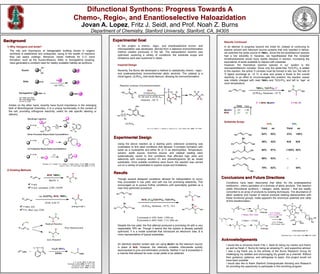
Difunctional Synthons: Progress Towards A Chemo-, Regio-, and Enantioselective Haloazidation
- 1. Difunctional Synthons: Progress Towards A Chemo-, Regio-, and Enantioselective Haloazidation Jovan A. Lopez, Fritz J. Seidl, and Prof. Noah Z. Burns Department of Chemistry, Stanford University, Stanford, CA, 94305 Background Experimental Design Conclusions and Future Directions 1) Why Halogens and Azide? The role and importance of halogenated building blocks in organic synthesis is established and undisputed, owing to the wealth of reactions they can easily undergo. Moreover, newer methods for C–C bond formation, such as the Suzuki-Miyaura, Stille, or Sonogashira coupling, have generated a constant need for readily available halides as synthons. Nicolaou, K. C.; Bulger, P. G.; Sarlah, D. Angew. Chem., Int. Ed. 2005, 44, 4442 Lang, K.; Chin, J. W. ACS Chem. Biol. 2014, 9, 16−20 2) Existing Methods Recently, the Burns lab developed a method to catalytically chemo-, regio-, and enatioselectively bromochlorinate allylic alcohols. The catalyst is a chiral ligand, (S,R)-Ln, that binds titanium, allowing for bromochlorination. Inspired Design Experimental Goal In this project, a chemo-, regio-, and enantioselective bromo- and chloroazidation was developed, derived from a selective bromochlorination method created previously in the lab. The haloazidation reaction was optimized, exploring a variety of conditions; the substrate scope and limitations were also examined in detail. Results Substrate Scope Acknowledgements I would like to sincerely thank Fritz J. Seidl for being my mentor and friend, as well as Noah Z. Burns for being an amazing P.I. and supportive advisor. I owe a big thank you to the entirety of the Burns Research Group for challenging my abilities and encouraging my growth as a chemist. Without their guidance, patience, and willingness to teach, this project would not have been possible. I would also like to thank Stanford Undergraduate Advising and Research for providing the opportunity to participate in this enriching program. R1 = alkyl, aryl, vinyl R2 = aryl, benzyl, vinyl X = Br, Cl, I, OTf Azides on the other hand, recently have found importance in the emerging field of Bioorthogonal Chemistry. It is a unique functionality in the context of the cell, providing orthogonal reactivity, useful for site specific labeling or delivery. C. R. Chimie. 2012, 15, 688–692 Tetrahedron Letters 2006, 47, 7017–7019 Org. Biomol. Chem., 2016, 14, 853 Org. Biomol. Chem., 2016, 14, 7463 Hu, D. X.; Seidl, F. J.; Bucher, C.; Burns, N. Z. J. Am. Chem. Soc., 2015, 137, 3795 Using the above reaction as a starting point, extensive screening was undertaken to find ideal conditions that allowed Ti-complex formation with azide as a nucleophile and either Br or Cl as electrophiles. Temperature, solvent, azide source, bromine source, and catalyst loading were systematically varied to find conditions that afforded high yield and selectivity with cinnamyl alcohol (1) and phenethylprenol (2) as model substrates. Once suitable conditions were found, the reaction was carried out on a variety of substrates to explore scope and limitations. Though several designed conditions allowed for haloazidation to occur, they proceeded in low yield, and with low but promising selectivity. This encouraged us to pursue further conditions until serendipity granted us a near fully optimized procedure. In an attempt to progress beyond the initial hit, instead of continuing to explore solvent and halonium source screens that only resulted in failure, we switched the azide source to TMSN3. Since the bis-azidotitanium species had a low solubility in hexanes, we hypothesized that the nonpolar trimethylsilylazide would more readily dissolve in solution, increasing the equivalents of azide available to interact with substrate. However, the theoretical reactive species in our system is the monoazidotitanium complex. Since only the azide-free Ti(Oi-Pr)4 is added to the reaction, the active Ti complex must be formed in situ; but, the rate of Ti ligand exchange at -15 oC is slow and poses a threat to the overall reactivity. In an effort to circumnavigate this problem, the reaction vessel was initially charged with neat TMSN3 and Ti(Oi-Pr)4 and left to “age” at room temperature. Conditions have been discovered that allow for the enatioselective anti(bromo-, chloro-)azidation of a diversity of allylic alcohols. This reaction yields trifunctional synthons – halogen, azide, alcohol – that are readily converted to an array of products by existing techniques. The abundance of allylic systems and myriad of natural products bearing stereocenters with these functional groups, make apparent the enormous potential and utility of this transformation. Despite the low yield, the first attempt produced a promising hit with a very respectable 78% ee. Though it seems like the system is already partially optimized, 1 is a model substrate that introduces an electronic bias. 2 is more representative of typical substrates. An identical reaction screen was ran using tBuOCl as the halonium source in place of NBS. However, the relatively unstable chloroazide quickly decomposed to junk and elimination products. Neither 1 nor 2 proceeded in a manner that allowed for even crude yields to be obtained. Results Continued Hanessian et al. J. Am. Chem. Soc. 2006 128, 10493